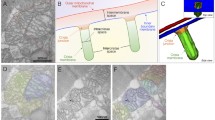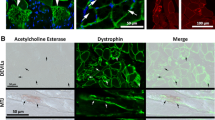Summary
Biopsies from three patients with different clinical and pathological stages of myotonic dystrophy were studied by phase and electron microscopy. Large sarcoplasmic masses and spiral annulets were prominent in Cases 1 and 2 while in Case 3, featured clinically by atrophic weakness, they were infrequent. In the latter the residual fibers were either large and dystrophic or small and atrophic.
Electron microscopically, nearly all components of the muscle cell, in places, were involved in the dystrophic or atrophic process, such as myofilaments, Z discs, triads, nucleic, mitochondria, and the sarcolemma. In addition, cytoplasmic cysts, multilammellated bodies, and lipofuscin granules were observed. The most characteristic feature of the disease were sarcoplasmic masses, filled with varying amounts of disoriented myofilaments and other sarcoplasmic components. Disoriented myofibrils often encircled the remaining core of normal myofibrils, thus forming the striated annulets (Ringbinden). Several other abnormalities, not previously reported in myotonic dystrophy or any other myopathy, were identified in slightly dystrophic as well as in severaly atrophic fibers. These were large, homogenous lacunes derived from the sarcoplasmic reticulum and peculiar geometric arrangements of terminal cisternae. The origin of some other structures remains obscure. The relation of the dystrophic process to segmental degeneration and atrophy, the principal histologic findings in Steinert's disease, is unsettled since segmental necrosis was not observed in our samples for phase and electron microscopy.
Zusammenfassung
Das Biopsiematerial von drei Patienten mit unterschiedlichen klinischen und pathologischen Stadien der myotonischen Dystrophie wurde phasenkontrast-und elektronenmikroskopisch untersucht. Beim 1. und 2. Fall waren “sarkoplasmatische Massen” und “Ringbinden” besonders zahlreich, während sie beim 3. Fall mit klinisch erheblich fortgeschrittener Muskelatrophie nur ausnahmsweise vorkamen.
Elektronenmikroskopisch erschienen fast alle Elemente der Muskelfasern, zumindest an einigen Stellen, von dem atrophischen oder dystrophischen Prozeß betroffen: Myofilamente, Z-Streifen, Triaden, Kerne, Mitochondrien und Sarkolemm. Außerdem fanden sich cytoplasmatische Cysten, multilamellierte Körperchen, zahlreiche Lipofuscingranula und verschiedene andere abnorme Strukturen. Besonders kennzeichnend für die Erkrankung waren die “sarkoplasmatischen Massen”, die mit variablen Mengen von fehlorientierten Myofilamenten, aber auch von anderen Komponenten der Muskelzelle ausgefüllt waren. Die Ringbinden wurden von fehlorientierten Myofibrillen gebildet, indem sie meist kreisförmig die im Zentrum normal ausgerichteten Myofibrillen umschlossen. Einzelne Veränderungen, die bisher weder bei der myotonischen Dystrophie noch in irgendeiner anderen Muskelkrankheit nachgewiesen worden sind, konnten in leicht dystrophischen wie auch in hochgradig atrophischen Fasern nachgewiesen und identifiziert werden: Große homogene Lacunen, die sich vom sarkoplasmatischen Reticulum herleiten und eigenartige geometrische Anordnungen der terminalen Cisternen. Der Ursprung bestimmter anderer Strukturen blieb unklar.
In unserem Material fanden sich keine segmentalen Nekrosen, so daß sich die Relation des dystrophischen Prozesses zur Zenkerschen Degeneration und zur Atrophie, den nach histologischen Untersuchungen wesentlichsten Befunden bei der Steinertschen Erkrankung, nicht eindeutig bestimmen ließ.
Similar content being viewed by others
References
Adams, R. D., D. Denny-Brown, andC. M. Pearson: Diseases of Muscle. A Study in Pathology. 2nd Edition. New York: Harper and Brothers 1962.
—, u.J. Rebeiz: Histopathologie der myotonischen Erkrankungen. In: Progressive Muskeldystrophie, Myotonie, Myasthenie. Hrsg. v.E. Kuhn, S. 191–203. Berlin-Heidelberg-New York: Springer 1966.
Aleu, F. P., andA. D. Afifi: Ultrastructure of muscle in myotonic dystrophy. Preliminary observations. Amer. J. Path.45, 221–231 (1964).
Anderson, P. J., andS. K. Song P. Slotwiner: Histochemical and electronmicroscopic study of sphero-membranous degeneration of skeletal muscle induced by vincristine. 42nd Annual Meeting of the American Association of Neuropathologists. June 10–12, 1966; Washington, D. C. J. Neuropath. exp. Neurol.26, 131–132 (1967).
Conen, P. E., E. G. Murphy, andW. L. Donohue: Light and electron microscopic studies of “myogranules” in a child with hypotonia and muscle weakness. Canad. med. Ass. J.89, 983–986 (1963).
Engel, A. G.: Electron microscopic observations in metabolic myopathies (three types of hypokalemic periodic paralysis, thyreotoxic myopathy and steroid-induced myopathy). 40th Annual Meeting of the American Association of Neuropathologists. Atlantic City, New Jersey. June 13 and 14, 1964. J. Neuropath. exp. Neurol.24, 141–142 (1965).
Engel, W. K.: The essentiality of histo-and cytochemical studies of skeletal muscle in the investigation of neuromuscular disease. Neurology (Minneap.)12, 778–794 (1962).
—: Diseases of the neuromuscular junction and muscle. In: Neurohistochemistry, pp. 622–672.C. W. M. Adams ed. Amsterdam-London-New York: Elsevier Publishing Comp. 1965.
Erbslöh, F.: Die myotonische Dystrophie. Eine intern-neurologische und bioptisch-histologische Studie. Arch. Psychiat. Nervenkr.201, 648–667 (1961).
Essner, E., andA. B. Novikoff: Localization of acid phosphatase activity in hepatic lysosomes by means of electron microscopy. J. biophys. biochem. Cytol.9, 773–784 (1961).
Estable-Puig, J. F., W. C. Bauer, andJ. M. Blumberg: Paraphenylenediamin staining of osmium-fixed plastic embedded tissue for light and phase microscopy. J. Neuropath. exp. Neurol.24, 531–535 (1965).
Fisher, E. R., R. E. Cohn, andF. S. Danowski: Ultrastructural observations of skeletal muscle in myopathy and neuropathy with special reference to muscular dystrophy. Lab. Invest.15, 778–793 (1966).
Gonatas, N. K., G. M. Shy, andE. H. Godfrey: Nemaline myopathy. The origin of nemaline structures. New Engl. J. Med.274, 535–539 (1966).
Heidenhain, M.: Über progressive Veränderungen der Muskulatur bei Myotonia atrophica. Beitr. path. Anat.64, 198–225 (1918).
Hewes, E. L., H. M. Price, andJ. M. Blumberg: Effects of diet producing lipochrome pigment (Ceroid) on the ultrastructure of skeletal muscle in rat. Amer. J. Path.45, 599–637 (1964).
——C. M. Pearson, andJ. M. Blumberg: Hypokalemic periodic paralysis. Electron microscopic changes in the sarcoplasm. Neurology (Minneap.)16, 242–256 (1966).
Lapresle, J., etM. Fardeau: Diagnostic histologique des atrophies et hypertrophies musculaires. In: 8th International Congress of Neurology, Vienna, 5.–10. 9. 1965, Proceedings II: Neuromuscular Disease, pp. 47–66.
Lee, J. C., andR. Altschul: Electron microscopy of the nuclei of denervated skeletal muscle. Z. Zellforsch.61, 168–182 (1963).
Milhaud, M., M. Fardeau, etJ. Lapresle: Contribution à l'étude des lésions élementaires des muscle squelettique ultrastructure des fibres annulaires (observer dans la dystrophie myotonique). C.R. Soc. Biol. (Paris)158, 2274–2275 (1964).
Palade, G. E., andP. Siekevitz: Liver microsomes. An integrated morphologic and biochemical study. J. biophys. biochem. Cytol.2, 171–200 (1956).
Peachy, L. D.: The sarcoplasmic reticulum and transverse tubules of the frog's sartorius. J. Cell Biol.25, 209–231 (1965).
Pellegrino, C., andC. Franzini: An electron microscope study of denervation atrophy in red and white skeletal muscle fibers. J. Cell Biol.17, 327–349 (1963).
Porter, K. R.: The sarcoplasmic reticulum. Its recent history and present status. J. biophys. biochem. Cytol.10, 219–226 (1961) Suppl.
Samaha, F. J., J. M. Schröder, J. Rebeiz, andR. D. Adams: Studies in myotonia: Biochemical and electron microscopic studies in myotonia congenita and myotonia dystrophica. Arch. Neurol. (Chic.)17, 22–33 (1967).
Schotland, D. L., D. Spiro, andP. Carmel: Ultrastructural studies of ring fibers in human muscle disease. J. Neuropath. exp. Neurol.25, 431–442 (1966).
——,L. P. Rowland, andP. Carmel: Ultrastructural studies of muscle in McArdle's disease. J. Neuropath. exp. Neurol.24, 629–644 (1965).
Schrodt, G. R., andS. M. Walker: Ultrastructure of membranes in denervation atrophy. Amer. J. Path.49, 33–57 (1966).
Shy, G. M., W. K. Engel, J. E. Somers, andTh. Wanko: Nemaline myopathy: New congenital myopathy. Brain86, 793–810 (1963).
—, andN. K. Gonatas: Human myopathy with giant abnormal mitochondria. Science145, 493–496 (1964).
Smith, D. S.: The organization and function of the sarcoplasmic reticulum and T-system of muscle cells. In: Progress in Biophysics and Molecular Biology, Vol. 16, pp. 107–142.J. A. V. Butler andH. E. Huxley, Ed. London: Pergamon Press 1966.
Somers, J. E., andN. Winer: Reversible myopathy and myotonia following administration of a hypocholesterolemic agent. Neurology (Minneap.)16, 761–765 (1966).
Spiro, A. J., G. M. Shy, andN. K. Gonatas: Myotubular myopathy. Persistence of fetal muscle in an adolescent boy. Arch. Neurol. (Chic.)14, 1–14 (1966).
Venable, J. H., andR. Coggeshall: A simplified lead citrate stain for use in electron microscopy. J. Cell Biol.25, 407–408 (1965).
Virchow, R.: Über das ausgebreitete Vorkommen einer dem Nervenmark analogen Substanz in den thierischen Geweben. Virchows Arch. path. Anat.6, 562–572 (1854).
Wechsler, W., andH. Hager: Elektronenmikroskopische Untersuchungen bei myotonischer Muskeldystrophie. Arch. Psychiat. Nervenkr.201, 668–690 (1961).
——: Elektronenmikroskopische Befunde bei Muskelatrophie nach Nervendurchschneidung bei der weißen Ratte. Beitr. path. Anat.125, 31–53 (1961).
Winer, N., D. M. Klachko, T. W. Burns, andR. D. Baer: Electromyographic myotonic response induced by cholesterol lowering agents. Arch. Phys. Med.46, 499–499 (1965).
Wohlfahrt, G.: Dystrophia myotonica and myotonia congenita. Histopathologic studies with special reference to changes in the muscles. J. Neuropath. exp. Neurol.10, 109–124 (1951).
Wolman, M.: Fatty metamorphosis. In: Handbuch der Histochemie. Hrsg. v. W. Graumann u.K. Neumann, Vol. V: Lipids. Second Part: Histochemistry of Lipids in Pathology, pp. 4–91. Stuttgart: Fischer 1964.
Author information
Authors and Affiliations
Additional information
From the Experimental Neuropathology Laboratories (Neurology service), Massachusetts General Hospital, and the Department of Neurology-Neuropathology, Harvard Medical School.
This study was supported by a Research Grant (NB 03789-05) from the National Institute of Neurological Diseases and Blindness, Bethesda, Maryland 20014, and a Fellowship from the Max Kade Foundation, New York.
Rights and permissions
About this article
Cite this article
Schröder, J.M., Adams, R.D. The ultrastructural morphology of the muscle fiber in myotonic dystrophy. Acta Neuropathol 10, 218–241 (1968). https://doi.org/10.1007/BF00687725
Received:
Issue Date:
DOI: https://doi.org/10.1007/BF00687725




